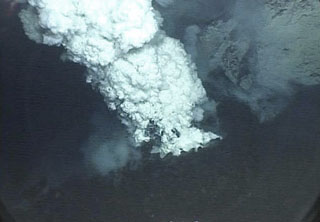Report on NW Rota-1 (United States) — February 2008
Bulletin of the Global Volcanism Network, vol. 33, no. 2 (February 2008)
Managing Editor: Richard Wunderman.
NW Rota-1 (United States) Visit on 24 February 2008 found eruption plume and acoustic signals
Please cite this report as:
Global Volcanism Program, 2008. Report on NW Rota-1 (United States) (Wunderman, R., ed.). Bulletin of the Global Volcanism Network, 33:2. Smithsonian Institution. https://doi.org/10.5479/si.GVP.BGVN200802-284211
NW Rota-1
United States
14.601°N, 144.775°E; summit elev. -517 m
All times are local (unless otherwise noted)
During an April 2006 expedition (BGVN 31:05), scientists from the National Oceanic and Atmospheric Agency (NOAA) and Oregon State University aboard the research vessel Melville witnessed the volcano ejecting lava, bombs, and sulfur-rich (SO2 and H2S) plumes. This is the first site where explosive submarine eruptions have been directly observed from a submersible (see Videos, below).
According to William Chadwick, a brief visit to NW Rota-1 was made on 24 February 2008. With support from the NOAA Ocean Exploration Program and the U.S. Coast Guard, the scientists deployed a hydrophone and plume sensor. While on site, scientists found that the volcano was still erupting. There were no instruments left after the April 2006 visit, so the observational record was discontinuous. On the other hand, scientists visited the site four times in four years and consistently found that it was active. Moreover, Chadwick and colleagues had collected multibeam bathymetry in 2003 and 2006 (Walker and others, in press). Depth changes between those surveys were up to +40 m and extended from the eruptive vent at 550 m directly downslope to at least 2,000 m. They were consistent with volcaniclastic deposits from ongoing eruptions. The suggestion is that NW Rota-1 has been very active, if not continuously active.
On 24 February 2008 the Melville crew made a vertical cast over the eruptive vent with a light-scattering sensor and detected an eruption plume below 500 m depth. Hydrophone data also indicated eruptions with cyclic bursts about once a minute. These appear very similar to the explosions observed by ROV and hydrophone in 2006 (Chadwick and others, 2008). The explosion sounds were louder and more frequent in 2008 than in 2006. During the 2008 visit, explosion signals filled the 24-hour acoustic record. Before departure, the crew installed a hydrophone and plume sensor to record activity over the next year.
Resing and others (2007) described two types of venting at NW Rota-1. The first was a focused plume rich in Al, S, Si, CO2, Fe, Mn, and 3He. The second was a plume with diffuse flow, rich in Fe, Mn, CO2, and 3He, but without Al, S, and Si. Data suggested that the pH of these plumes were less than 1.0, primarily due to SO2 and possibly HCl. The authors claimed that the volcano is producing some of the greatest chemical anomalies ever observed in non-buoyant hydrothermal plumes and greatly different from that observed in any other hydrothermal setting.
Videos. Eruption videos taken from an unmanned submersible on 29 April 2006 can be found at http://www.oceanexplorer.noaa.gov/explorations/06fire/logs/april29/april29.html website. The five videos are titled as follows: (1) The extremely dynamic Brimstone Pit, (2) Brimstone Pit erupting with glowing red lava jetting out of the vent, (3) Brimstone Pit erupting with glowing red lava and gas bubbles, (4) Brimstone Pit sulfur plume envelopes the Jason ROV [remotely operated vehicle], and (5) The pulse and shake of the Brimstone Pit during another eruption.
References. Chadwick, W.W., Jr., Cashman, K.V., Embley, R.W., Matsumoto, H., Dziak, R.P., de Ronde, C.E.J., Lau, T.-K., Deardorff, N., and Merle, S.G., 2008, Direct video and hydrophone observations of submarine explosive eruptions at NW Rota-1 volcano, Mariana Arc: J. Geophys. Res.-Solid Earth, doi:10.1029/2007JB005215 (in press).
Resing, J.A., Lebon, G., Baker, E.T., Lupton, J.E., Embley, R.W., Massoth, G.J., Chadwick, Jr., W.W., and de Ronde, C.E.J., 2007, Venting of acid-sulfate fluids in a high-sulfidation setting at NW Rota-1 submarine volcano on the Mariana Arc: Economic Geology, v. 102, no. 6, p. 1047-1061.
Walker, S.L., Baker, E.T., Chadwick, Jr., W.W., Resing, J.A., Lebon, G.T., Lupton, J.E., and Merle S.G., (in press), Eruption-fed particle plumes and volcaniclastic deposits at a submarine volcano: NW-Rota-1, Mariana Arc: J. Geophys. Res.
Geological Summary. A submarine volcano detected during a 2003 NOAA bathymetric survey of the Mariana Island arc was found to be hydrothermally active and named NW Rota-1. The basaltic to basaltic-andesite seamount rises to within 517 m of the ocean surface SW of Esmeralda Bank, 64 km NW of Rota Island and ~100 km N of Guam. When Northwest Rota-1 was revisited in 2004, a minor submarine eruption from a vent named Brimstone Pit on the upper south flank about 40 m below the summit intermittently ejected a plume several hundred meters high containing ash, rock particles, and molten sulfur droplets that adhered to the surface of the remotely operated submersible vehicle. The active vent was funnel-shaped, about 20 m wide and 12 m deep. Prominent structural lineaments about a kilometer apart cut across the summit of the edifice and down the NE and SW flanks.
Information Contacts: William Chadwick and Robert Dziak, Oregon State University and NOAA Vents Program, Newport, Oregon; 2115 SE OSU Drive, Newport, OR 97365 USA (URL: http://oceanexplorer.noaa.gov/explorations/06fire/welcome.html).

